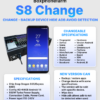In the context of increasingly powerful connectivity technology, IPv6 Proxy has become an important concept that helps users maintain safety and efficiency while using the internet. In this article, GenFarmer will explore IPv6 Proxy in more depth, how it works, and the differences between IPv4 and IPv6, thereby providing useful suggestions for users.
What is an IPv6 Proxy?
IPv6 Proxy (Internet Protocol version 6) is a modern networking solution that acts as an intermediary between your device and the Internet. This technology uses the IPv6 Proxy protocol, an improved and more powerful version of the IP protocol, to establish connections and transmit data. When you use an IPv6 Proxy to access a website, your request is forwarded through the proxy server before reaching its destination, which helps protect your real IP address and enhance security.
IPv6 Proxy was created to replace IPv4, the older version that is gradually running out of resources. With its enormous address space, IPv6 Proxy completely solves the problem of IP address shortages and supports more flexible deployment of personalized services. In addition, IPv6 Proxy integrates many advanced security features, making it the optimal choice for applications that require high security.

What are the advantages of an IPv6 Proxy?
IPv6 Proxy offers many outstanding benefits to users, from security and speed to scalability. Below are the main advantages that IPv6 Proxy provides.
Enormous Address Space
The first notable feature of IPv6 Proxy is the vast IP address space it provides. While IPv4 has only about 4 billion IP addresses, IPv6 Proxy can support up to 340 undecillion IP addresses (340 x 10^36). This means that users can easily obtain a unique IP address without worrying about resource shortages.
Having a large address space also facilitates the development of the Internet of Things (IoT), where millions of devices are increasingly connected to each other. By using IPv6 Proxy, users can leverage this benefit to ensure that all devices can connect and interact effectively.
Enhanced Security
IPv6 Proxy provides a stronger layer of security compared to previous protocols. By encrypting data and hiding the user’s real IP address, IPv6 Proxy helps prevent cyberattacks and minimizes the risk of being tracked. Additionally, many IPv6 Proxy service providers now use additional security techniques such as firewalls and antivirus software, further increasing user safety.
Protecting personal information is a significant concern, especially in the context of an increasing number of cyberattacks. Using an IPv6 Proxy is an effective solution to protect user privacy, helping them feel more secure when accessing sensitive websites or conducting online transactions.
Scalability and Flexibility
One of the biggest advantages of IPv6 Proxy is its scalability and flexibility. Businesses can easily expand their systems without worrying about a shortage of IP addresses. This is particularly important for companies looking to grow in the digital business environment.
In addition, IPv6 Proxy also allows for easier integration with cloud services and mobile applications. This provides users with convenience in managing and operating their systems, thereby optimizing work performance.
Quality of Service
The quality of service that IPv6 Proxy provides is equally important. Many IPv6 Proxy service providers commit to providing fast access speeds, low latency, and high stability. This ensures that users will not experience interruptions or delays while using the internet.
Quality of service not only affects the user experience but is also related to business operations. a stable and fast connection can help improve work performance and create value for the business.

Applications of IPv6 Proxy
IPv6 Proxy is not just a security tool but also has many different practical applications in daily life as well as in the business environment. Let’s explore the outstanding applications of IPv6 Proxy.

Accessing Restricted Content
One of the most popular applications of IPv6 Proxy is accessing regionally restricted content. Users can easily bypass geographical barriers and enjoy their favorite content without being limited by their geographical location. This is very appealing to those who love watching movies, listening to music, or playing games online.
SEO Optimization
In the field of online marketing, IPv6 Proxy also plays an important role in SEO optimization. Marketers can use IPv6 Proxy to check keyword rankings on search engines from various locations. This gives them a more comprehensive view of how their marketing strategy is performing and allows them to adjust accordingly.
Securing Business Information
Businesses can use IPv6 Proxy to protect sensitive information and customer data. By hiding the actual IP address and encrypting data, IPv6 Proxy helps minimize the risk of information leaks and cyberattacks. This is especially important as many businesses are now transitioning to remote work environments.
Data Management and Analysis
IPv6 Proxy can also be used for data management and analysis. Organizations can leverage IPv6 Proxy to collect information from various sources without being detected. This helps them obtain valuable data to support decision-making and build business strategies.
How an IPv6 Proxy Works
An IPv6 Proxy acts as a bridge between the user and the internet, helping to process access requests efficiently. To better understand how an IPv6 Proxy works, let’s delve into each step of this process.

Sending a Request
When a user wants to access a website, their device sends a request to the IPv6 Proxy. This request typically includes the URL of the website and other information necessary to complete the transaction.
The IPv6 Proxy receives this request and begins the authentication and processing procedure. One of the strengths of IPv6 Proxy at this stage is its ability to hide the user’s real IP address, thereby helping to protect privacy from the moment the request is sent.
Processing the Request
After receiving the request from the user, the IPv6 Proxy will process it by looking up the address of the website the user wants to access. The proxy will send an access request to the website’s server on behalf of the user.
This process is not just a simple forwarding of the request; the IPv6 Proxy can also perform additional actions such as checking the validity of the request or applying security measures to ensure that the request is not tampered with. This enhances the security and reliability of the service.
Receiving and Returning the Result
When the website’s server responds to the request, the IPv6 Proxy will receive the data and then forward it back to the user. Through this step, the user does not need to know the real IP address of the server they requested, thus keeping their personal information private.
The response data can include HTML, images, videos, or any other format that the user requested. This allows users to access the desired content without worrying about being tracked or detected.
Displaying the Result
Finally, once the IPv6 Proxy has received and processed the data, it will display the result to the user on their device’s interface. This information is usually presented as a complete webpage, which may include interactive and multimedia elements.
This not only ensures a seamless Browse experience but also helps users feel more comfortable using the service. Everything happens quickly and smoothly, creating a high-quality experience for the user.
Criteria for Choosing an IPv6 Proxy Provider
Choosing a suitable IPv6 proxy provider is a crucial step to ensure quality service and meet your usage needs. Below are the criteria you should consider when making a choice:
- Speed and Stability: The provider must ensure sufficient bandwidth to maintain fast connection speeds, especially when using a proxy to download large files or stream online videos. The proxy also needs to operate stably, minimizing disruptions as much as possible.
- Security: Prioritize providers that support strong encryption protocols like HTTPS to protect transmitted data. Also, carefully review the privacy policy to ensure your personal information is kept safe.
- Number and Location of IP Addresses: A provider with a large number of IP addresses will offer more flexible IP changing options. If you need to access geo-restricted content, choose a provider with IPs in the corresponding country.
- Proxy Type: Choose the proxy type that suits your needs, such as HTTP Proxy, SOCKS Proxy, or HTTPS Proxy.
- Service Policy: Check factors like bandwidth limits, the number of simultaneous device connections, and the refund policy if the service does not meet requirements. 24/7 customer support and detailed user guides are also important factors to consider.
- Price; Price is an important factor to consider. Compare costs between providers to find a service package that fits your budget. Also, evaluate the included features such as warranty, maintenance, and service upgrades.
- Provider’s Reputation: Read reviews from other users to get an overview of the provider’s quality and reliability.
Choosing the right IPv6 proxy provider requires careful consideration of many factors. Research and compare providers to make the best decision for your needs.

Differences Between IPv4 and IPv6 Proxy
The differences between IPv4 and IPv6 are not just in the number of addresses but also in many other aspects. Below are some notable differences between these two protocol versions.

IPv4 Proxy and IPv6 Proxy have key differences in IP address type, compatibility, popularity, and scalability. Here are the details of each difference:
IP Address Type:
- IPv4 Proxy uses 32-bit IPv4 addresses.
- IPv6 Proxy uses 128-bit IPv6 addresses, providing a significantly larger address space.
Compatibility:
- IPv4 Proxy works well on applications and services based on the IPv4 network.
- IPv6 Proxy is compatible with IPv6 network applications and services. However, to work with services that only support IPv4, IPv6 Proxy needs a translation and compatibility mechanism.
Popularity and Support:
- IPv4 Proxy is more common, widely used, and receives good support from the network community.
- IPv6 Proxy is being gradually deployed as the IPv6 network grows, but its popularity and support are not on par with IPv4 Proxy due to the infrastructure being mainly based on IPv4.
Scalability:
- IPv4 Proxy is limited because the IPv4 address space is nearly exhausted.
- IPv6 Proxy overcomes this problem with its enormous address space, allowing for easier expansion.
Basic Differences in Price and Quality:
- IPv4 Proxy is more expensive than IPv6 Proxy due to the scarcity of IPv4 addresses.
- In terms of quality, both types of proxies are equivalent in data transmission.
Technical Differences:
- Address Length: IPv4 uses a 32-bit address length, while IPv6 is 128-bit.
- Address Representation: IPv4 represents addresses in decimal format, while IPv6 uses hexadecimal.
- Packet Fragmentation: IPv4 relies on intermediate routers, while IPv6 performs fragmentation at the endpoint.
- Packet Header: The IPv4 header is 20 bytes long, while the IPv6 header is 40 bytes with a simpler structure.
- Data Transmission Method: IPv4 uses broadcast, while IPv6 uses multicast.
- Security: IPv6 integrates authentication and encryption, whereas IPv4 does not directly support it.
IPv4 Proxy and IPv6 Proxy have their own pros and cons related to address type, compatibility, popularity, and scalability. The choice of which proxy type to use depends on the specific needs and network environment you are using.
Below is a table comparing the 10 main differences between IPv4 Proxy and IPv6 Proxy:
| No. | IPv4 Proxy | IPv6 Proxy |
|---|---|---|
| 1 | IPv4 is a 32-bit IP address | IPv6 is a 128-bit IP address |
| 2 | Uses numbers and dots to separate the numbers | Uses numbers, letters, and is separated by colons |
| 3 | Supports multicast, unicast, and broadcast | Supports unicast, multicast, and anycast |
| 4 | Not very suitable for mobile devices | More suitable for mobile devices |
| 5 | Requires configuration before communicating with other systems | Configuration is not mandatory, depends on the required function |
| 6 | Poor security, not developed based on security criteria | Integration of network security (IPSec) is mandatory |
| 7 | Supports 12 header fields | Supports 8 header fields |
| 8 | Has optional fields | No optional fields, uses extension headers instead |
| 9 | Most websites support its use | Only some websites support it, the number of websites is gradually increasing |
| 10 | More expensive | Cheaper |
The choice between IPv4 and IPv6 Proxy depends on your specific usage needs and network requirements. IPv6 is the future with the advantages of a larger IP address space and better security, while IPv4 is still popular and widely supported.
Which network protocol should be used?
There is no absolute answer as to which network protocol should be used, as both IPv4 and IPv6 play an important role in internet connectivity.
However, in terms of long-term benefits, IPv6 is a better choice due to its large address space, which solves the problem of IPv4 exhaustion. Although there are currently solutions to continue using IPv4, these methods can affect connection speed and pose a potential risk of causing some technical issues.
In terms of speed, there is no significant difference between IPv4 and IPv6. The transition from IPv4 to IPv6 is essentially just an expansion of the IP address space, helping to meet the growing demands of users worldwide.
In summary, the choice of protocol depends on specific needs and conditions, but IPv6 will gradually become the standard in the future as the internet network continues to develop.

Is it possible to combine IPv4 Proxy and IPv6 Proxy?
IPv4 and IPv6 cannot communicate directly with each other, which makes integrating and adjusting the use of both protocols complex. Currently, the majority of websites and applications only support IPv4. Therefore, a complete transition to IPv6 will only be feasible when websites also support this protocol.
The transition from IPv4 to IPv6 is a long-term roadmap because IPv4 is still the legacy foundation on which many programs and applications are built. A complete transition to IPv6 in the future will help optimize the IP address space but may cause disruptions or loss of access to some applications and services that do not yet support IPv6.
Understanding the pros and cons of IPv4 and IPv6 is the basis for you to choose the appropriate proxy type:
- IPv4 Proxy: This is the main solution if you need to access websites and services that do not yet support IPv6.
- IPv6 Proxy: This can be used to access websites or applications that support IPv6, taking advantage of the vast IP address space that IPv6 offers.
IPv6 is considered the future of the internet because of its ability to provide a superior number of IP addresses. Although there are still some current limitations, using an IPv6 proxy is a strategic step that helps businesses and individuals adapt to technological developments in the near future.

Conclusion
In summary, IPv6 Proxy is increasingly becoming an important tool for protecting user privacy and optimizing the online experience. With many outstanding advantages such as a vast address space, enhanced security, and flexible scalability, IPv6 Proxy is not only a solution to the problem of IP address shortages but also a smart choice for those who want to improve work performance and protect personal information.
Choosing a reputable IPv6 Proxy service provider and correctly assessing your own usage needs will help users make the most of the benefits that IPv6 Proxy offers. With the continuous development of technology, the adoption of IPv6 Proxy will be an inevitable trend in the near future.











